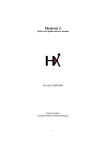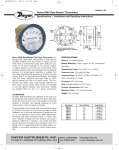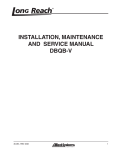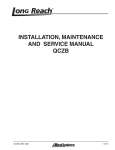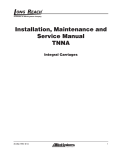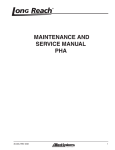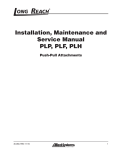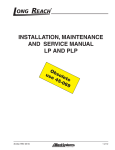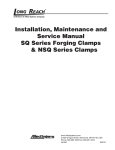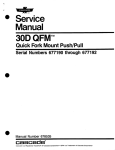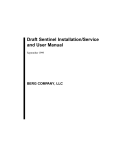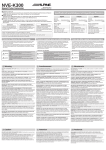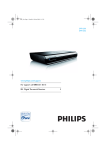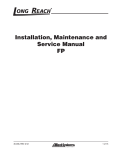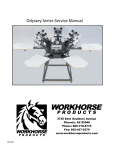Download INSTALLATION, MAINTENANCE AND SERVICE MANUAL FMP
Transcript
INSTALLATION, MAINTENANCE AND SERVICE MANUAL FMP, PLP, and PSR SERIES Obs Use olete 45069 45-033, REV. 05/10 1 of 16 TABLE OF CONTENTS SECTIONPAGE SECTIONPAGE 1 NAME PLATE LOCATION.............3 5 SERVICE PROCEDURE 2 MODEL NO. DESCRIPTION FMP MODEL NUMBER........................... 4 PLP MODEL NUMBER............................ 5 PSR MODEL NUMBER............................ 6 5.1 5.2 5.3 ATTACHMENT REMOVAL........................14 CYLINDER REMOVAL............................. 14 CYLINDER INSTALLATION.......................14 6 MAINTENANCE SCHEDULE 3 SAFETY SUMMARY 3.1 3.2 3.3 3.4 3.5 GENERAL INFORMATION....................... 7 LOAD HANDLING.................................... 8 LOAD POSITIONING................................ 8 HYDRAULICS...........................................9 OPERATION CONTROLS.........................9 6.1 6.1 6.2 QUICK ATTACHMENT REMOVAL.......... 15 SCHEDULE............................................16 TORQUE SPECIFICATIONS.....................16 4 INSTALLATION PROCEDURE 4.1 4.2 4.3 4.3a 4.3b TRUCK REQUIREMENTS.........................10 HYDRAULICS............................................10 ATTACHMENT INSTALLATION................ 10 QUICK HOOK INSTALLATION .................11 QUICK HOOK PIN-STYLE CLASS CONVERSION.......................................... 12 HYDRAULIC CONNECTIONS...................13 4.4 2 of 16 45-033, REV. 05/10 SECTION 1 NAMEPLATE LOCATION NOTE: WHEN YOU RECEIVE YOUR ATTACHMENT, LOCATE THE LONG REACH NAMEPLATE (UPPER LEFT CORNER ON THE BODY OR FRONT OF BASE UNIT) AND RECORD THE INFORMATION TO THE BLANK NAMEPLATE TAG WITH THE DATE RECEIVED IN THE SPACE PROVIDED ON THE BOTTOM OF THIS PAGE. IF THE NAME PLATE IS MISSING, LOOK FOR THE SERIAL NUMBER STAMPED DIRECTLY INTO THE METAL AT THE ORIGINAL LOCATION AND CONSULT FACTORY. Nameplate A Date Received: - 45-033, REV. 05/10 - 3 of 16 SECTION 2 MODEL NUMBER DESCRIPTION Each clamp is identified by a model number and a serial number located on the name plate attached to the unit prior to shipment. Long Reach’s model numbers are designed to describe how an attachment is equipped. The guide below illustrates the information that is represented in a model number. Always include model and serial number when ordering parts or requesting service information. FMP Series Model Number: F M P 3 5 N N G P 8 PLATEN SERIES FMP = Fork Mount Push / Pull PLATEN THICKNESS G = 0.375” H = 0.500” CAPACITY 30 = 3000 lb capacity 35 = 3500 lb capacity 45 = 4500 lb capacity OPTIONAL FUNCTION N = Non-Side Shift PLATEN MOVEMENT N = Fixed 4 8 O N O N N N USEABLE PLATEN LENGTH 40 = 40” 44 = 44” 48 = 48” PLATEN WIDTH 1 = 40” 5 = 15” 8 = 18” OPTIONS ONO = None H55 = LH Termination MOUNTING Fork Mounted HOOK TYPE N/A MOUNTING ANGLE N/A 4 of 16 45-033, REV. 05/10 PLP Series Model Number: P L P 3 5 N M B P 5 PLATEN TYPE S = Solid SERIES PLP = Quick Mount Push / Pull PLATEN THICKNESS B = 1” G = 0.38” CAPACITY 30 = 3000 lb capacity 35 = 3500 lb capacity 45 = 4500 lb capacity OPTIONAL FUNCTION N = Non-Side Shift S = Side Shift PLATEN MOVEMENT M = Manual N = Fixed 4 8 R N O A Q 0 USEABLE PLATEN LENGTH 40 = 40” 44 = 44” 48 = 48” PLATEN WIDTH 5 = 15” 8 = 18” OPTIONS RNO = None ONO = None MOUNTING CLASS A = ITA Class II HOOK TYPE Q = Quick Change MOUNTING ANGLE 0 = 0 deg 45-033, REV. 05/10 5 of 16 PSR Series Model Number: P S R 5 0 N SERIES PSR = Quick Mount Push / Pull PUSH STROKE 50” F P D 1 4 8 C B A 1 Q 0 USEABLE PLATEN PLATEN TYPE LENGTH S = Solid P = Platen D148= 1.25”x11”x48” CUSTOMER DESIGNATION CB = Coors Brewery OPTIONAL FUNCTION NF = Non-Side Shifting MODEL SPECIFICATION 1 = Standard MOUNTING CLASS AQ= ITA Class II W/Quick Release Mounting Hooks 6 of 16 MOUNTING ANGLE 0 = 0 deg 45-033, REV. 05/10 SECTION 3 SAFETY SUMMARY 3.1 General Information Safety is Everyone’s Responsibility Whether you are new on the job or a seasoned veteran, these safety tips may prevent injury to you, to others, or to the materials you are handling. Always be alert, watch out for others, and follow these suggestions: Attachments Handle Material - Not People. SAFETY STARTS WITH COMMON SENSE. GOOD JUDGEMENT, PROPERLY MAINTAINED EQUIPMENT, CAREFUL OPERATION, AND PROPERLY TRAINED OPERATORS. 1. Check your equipment before you operate it. 2. Check to make sure the attachment on your truck is the same as on the truck capacity plate. Figure 3-1 9. Never use the attachment or its load to support a man carrying device. 10. Never position an attachment or load over people. (Figure 3-2) 3. Check for hydraulic leaks and cracked hoses or fittings. 4. Check the hydraulic oil level in the lift truck hydraulic reservoir. 5. Check for physical damage to the attachment. If anything looks wrong, unusual or different, report it before using the attachment. 6. When removing / installing dismountable attachments always keep hands and feet free from dangerous positions or pinch points. Never leave a dismounted attachment in a dangerous position. 7. Check to make sure that the dismountable attachment is properly secured to the truck carriage before using the lift truck and attachment. 8. Never stand on top of material being raised, lowered, or transported. (Figure 3-1) 45-033, REV. 05/10 Figure 3-2 11. Never leave an attachment or load in an elevated position. 12. Never reach through the mast of the truck. Keep all parts of the body within the driver’s compartment. 13. Never leave a lift truck unattended without lowering the load to the floor, setting the brake, and turning the truck off. 7 of 16 14. Always operate an attachment from the operator’s seat, never while standing next to the lift truck. 15. Never stand in front of or beside an attachment that is being operated. Never allow another person to approach an attachment that is being operated. (Figure 3-3) 6. Do not use an attachment to open or close boxcar doors. Doing so can severely damage the attachment and cause loss of warranty. Damage to clamp arms may result in product damage. 7. Do not carry loose items or unsupported loads on top of a clamped load. 16. Do not allow riders on the truck at any time. 8. Never allow anyone under a load or under the carriage. 9. Never use chains, cables, or other devices in conjunction with an attachment for load handling. 10. Never clamp loads other than what the attachment was designed to handle. Figure 3-3 17. Always use reverse when carrying a load that impedes full vision. 18. Watch for pedestrians when transporting. Sudden stops can dislodge all or part of a load. 3.2 Load Handling 1. All operators must be trained and qualified. 2. Never overload the attachment. Refer to the attachment nameplate for the rated capacity of the attachment. Refer to the nameplate of the truck for the net working capacity of the truck and attachment. Observe the lower of the two capacities. The attachment capacity is the structural rating of the attachment and should not be exceeded. Net working capacity is the truck manufacturer’s rating of the truck/ attachment combination. 3. Never use a load to support or move another object. Doing so can easily exceed the holding capacity of the attachment, causing loss of the load. 4. Never lift, lower, side shift, pivot, rotate, or tilt loads while traveling. Repositioning loads while traveling affects the stability of the truck and may impede vision or clearances. 5. Never speed or race a lift truck. High speed aversely affects the stability and steering of the lift truck. 8 of 16 11. Travel slowly around corners. Sound horn on blind corners. Be careful of tail swing and overhead clearances. Watch in all directions. Avoid sudden stops. 12. Do not exceed the specified maximum operating pressure or flow for the attachment. To do so can severely damage the attachment and cause loss of warranty. 3.3 Load Positioning 1. Always operate an attachment from the driver’s seat. 2. Always lower the attachment if you need to leave the lift truck. Remember a lift truck supporting a load requires your full attention. 3. Never use the attachment or it’s load to support or move other loads or equipment. 4. Always carry loads as close to the floor as possible, consistent with the surface being traversed. Scraping or bumping the floor surface with the load or the attachment can severely damage the attachment and cause product damage. The mast should be tilted back. 5. Always keep the load positioned as close as possible to the horizontal center of the lift truck. 6. Always back down ramps or inclines. Driving forward down a ramp or incline with a clamped load will lessen the stability of the truck. (Figure 3-4) 45-033, REV. 05/10 7. Do not cross dock boards or dock levelers with the attachment or carriage fully lowered. Ramming the front or rear of the attachment against a dock board can cause severe damage. 3. Assume that all hydraulic hoses and components are pressurized. Relieve all hydraulic pressure before disconnecting any hydraulic line. 8. Always check loads to be handled. If they are broken, 4. Never try to stop or check for a hydraulic leak with any part of your body; use a piece of cardboard to check for hydraulic leaks. Small hydraulic hose leaks are extremely dangerous, and can inject hydraulic oil under the skin, even through gloves. Infection and gangrene are possible when hydraulic oil penetrates the skin. See a doctor immediately to prevent loss of limb or death. Figure 3-4 unbalanced, loose, or too heavy, advise a supervisor or properly correct the situation prior to handling. 9. Limit lift truck movement to a minimum when high stacking. Limit sideshift movement to a minimum when high stacking. 10. Always be observant when high stacking. Look for poorly stacked loads, overhead obstacles, broken cartons, or damaged products in the stack. 3.5 Operator’s Controls 1. For clarity, the direction of arm movement is shown on the control handle. To move the arms in the direction shown, pull the handle towards the operator. To move the arms in the opposite direction, the push the handle away from the operator. 11. Always carry cylindrically shaped loads in the vertical position, not the horizontal. 12. Always clamp loads with the contact pads, if applicable, not the arm or arm base. 13. Never rotate a load that is off center to the centerline of rotation. Severe damage to the rotator could result. Clamp Fork Positioner 14. Always check the attachment for proper fit and engagement of the truck carriage. 3.4 Hydraulics 1. Be aware of the hazards of pressurized hydraulics: 2. Wear personal protective equipment, such as gloves and safety glasses, whenever servicing or checking a hydraulic system. 45-033, REV. 05/10 Push / Pull Rotate Side Shift Figure 3-5 NOTE: OSHA OR STATE REGULATIONS MAY REQUIRE THE INSTALLATION OF BACKRESTS. WE SUGGEST THAT YOU CHECK YOUR APPLICATION AGAINST THOSE REQUIREMENTS. 9 of 16 SECTION 4 INSTALLATION PROCEDURE 4.1 Truck Requirements Long Reach attachments have been designed to operate within specific limits. Operating pressures above the stipulated maximum may cause structural damage to the attachment and may result in loss of warranty. Hydraulic flow less than the recommended rates, or the use of small I.D. hoses may reduce operating speed. Higher flow can result in excessive heat buildup, erratic operation and damage to the truck / attachment hydraulic system. NOTE: IT IS THE RESPONSIBILITY OF THE DEALER AND / OR THE USER EITHER TO FURNISH AND INSTALL THE REQUIRED VALVING TO MEET THE RECOMMENDED HYDRAULIC PRESSURES AND FLOW OR TO ARRANGE INSTALLATION OF THE REQUIRED VALVING AT THE TRUCK FACTORY OR AT LONG REACH. THE MODEL DESCRIPTION, FOUND ON YOUR SHIPPED INVOICE, WILL STATE THE FOLLOWING TRUCK REQUIREMENTS: FLOW (GPM), PSI, AND MIN. TRUCK CARRIAGE WIDTH. THE CAPACITY OF THE TRUCK AND ATTACHMENT COMBINATION MAY BE LESS THAN THE CAPACITY SHOWN ON THE ATTACHMENT ALONE. CONSULT TRUCK NAMEPLATE! 2. Purging can be accomplished by installing a jumper line and operating each hydraulic function (clamp, rotate and side shift if equipped) in each direction for a minimum of 30 seconds. (Figure 4-1) 4.2 Hydraulics 1. The truck hydraulic system must supply to the attachment hydraulic oil that meets the specifications required to operate the attachment properly. 2. When the truck hydraulic system pressures exceed this maximum, a relief valve is recommended in the attachment auxiliary system of the truck or on the attachment. 3. Consult the truck factory and / or Long Reach for guidance. Figure 4-1, Jumper Line 3. Slide out the Fork Latch Assembly to install attachment to forks. The Retainer Pin needs to be lifted up to allow the Fork Latch Assembly to slide out. (Figure 4-2) 4.3 Attachment Installation 1. Prior to connecting the truck hydraulic system to the attachment, the system must be purged through the filtration system. This will eliminate any contamination that might exist in the auxiliary hydraulic system of the truck. Figure 4-2, Fork Latch Assembly 10 of 16 45-033, REV. 05/10 4. Center the truck behind the attachment and drive toward the attachment until the forks are completely inserted into the attachment. 5. When forks are flush against the attachment, lock the attachment to the forks by sliding the Fork Latch Figure 4-1, Jumper Line Figure 4-3, Fork Installation 4.3a Quick Hook Attachment Installation 1. Prior to connecting the truck hydraulic system to the attachment, the system must be purged through the filtration system. This will eliminate any contamination that might exist in the auxiliary hydraulic system of the truck. 3. Remove the lower bolt-on hooks and, if applicable, make a note of any factory installed shims. Shims are used to create clearance between the hook and carriage. If the attachment is equipped with Quick Change Hooks, simply depress the button on the back of the hooks, allowing the slide plate to drop. Removal of the Quick Change Hooks is NOT recommended. (Figure 4-2) THE CAPACITY OF THE TRUCK AND ATTACHMENT COMBINATION MAY BE LESS THAN THE CAPACITY SHOWN ON THE ATTACHMENT ALONE. CONSULT TRUCK NAMEPLATE! 2. Purging can be accomplished by installing a jumper line and operating each hydraulic function (clamp, rotate and side shift if equipped) in each direction for a minimum of 30 seconds. (Figure 4-1) Figure 4-2, Quick Change Hook 45-033, REV. 05/10 11 of 16 4. Center the truck behind the attachment and drive toward the attachment with the mast tilted forward approximately 4 degrees. 5. Line up the locking lug (under the hanger plate, if applicable) with the appropriate notch on the truck’s carriage. Check that the bronze side shifting wear strips are in the proper place, if applicable. 6. Slowly raise the truck carriage completely to engage the top hooks with the truck carriage. Tilt carriage back until the unit is against the carriage bottom fork bar (0 degrees). 7. Inspect for proper engagement of the locking lug in the corresponding notch of the truck’s carriage. Inspect any wear strips, if applicable, to insure they are properly aligned in the top hooks. 8. Install the bolt-on lower hooks. Inspect clearance to the carriage on lower hooks. Adjust the lower hooks for a maximum clearance of 3/32” (see Figure 4-3). Tighten the bolts to 40-50 ft-lbs. 9. If Quick Hooks are installed, simply raise the slide plate until the button clicks into place. THIS SLIDE PLATE MUST “CLICK” INTO PLACE TO ENSURE THE ATTACHMENT IS SECURED TO THE CARRIAGE. IF THE SLIDE PLATE DOES NOT CLICK INTO PLACE, (BECAUSE THE TRUCK CARRIAGE PREVENTS THE SLIDE PLATE FROM BEING RAISED UP HIGH ENOUGH), SHIMS MUST BE INSTALLED BETWEEN THE ATTACHMENT AND THE BODY OF THE QUICK CHANGE HOOKS. 10. To ensure proper locking of the slide plate, use a screwdriver to try to pry down the slide plate. If the slide plate is not locked in place, inspect and correct any cause that might restrict the slide plate from going up enough to allow the button to become fully engaged. 11. If Pin-Style Quick Hooks are installed, slowly raise the truck carriage completely to engage the top hooks with the truck carriage. Tilt carriage back until the unit is against the carriage bottom fork bar (0 degrees). 12. Remove detent pin and slide hook snugly against carriage. Reinstall the detent pin. 4.3b Quick Hook Pin-Style Class Conversion 1. Remove mounting bolts and slide off Quick Hook Assembly. 2. Select the correct class Quick Hook Assembly for your application and install assembled as shown in Figure 4-4. Note that the hook assemblies for Class II and Class III have different length bolts. Slide lower hook against carriage, install mounting bolts and insert detent pin into the lower hole (up position). Figure 4-3, Lower Hook Clearance 12 of 16 45-033, REV. 05/10 a. Inspect all hoses and fittings for leaks and routing clearance. Be sure to include clearance for jumper hoses to the mast. b. Check the valve and cylinder for leaks. c. Check cotter pins at each end of the cylinder for security. 6. After completing the installation, operate the attachment without a load for several cycles to remove any air in the hydraulic system. Test the attachment with a load to make sure the attachment operates correctly. Figure 4-4, Quick Change Pin-Style Hook 4.4 Hydraulic Connections 1. Install the lines from the truck’s hydraulics to the hydraulics of the attachment. (Figure 4-5) ANY ALTERATIONS TO THE ORIGINAL ATTACHMENT MAY AFFECT PERFORMANCE OR SAFETY AND RESULT IN LOSS OF WARRANTY. Figure 4-5, Truck Connection 2. Inspect installation to ensure hoses are not kinked or pinched between the truck carriage and attachment. 3. Operate the attachment continuously for several minutes to determine that all hydraulic connections are secure with no leaks. 4. Activate cylinders fully and check that the truck’s hydraulic reservoir oil level is at the recommended level. 5. Before placing the attachment in operation check the following: 45-033, REV. 05/10 13 of 16 SECTION 5 SERVICE PROCEDURE 5.1 Attachment Removal BEFORE DISCONNECTING ANY HYDRAULIC CONNECTIONS BE SURE TO TURN OFF THE TRUCKS POWER AND ACTIVATE THE TRUCKS HYDRAULIC FUNCTIONS IN BOTH DIRECTIONS TO BLEED OFF THE HYDRAULIC PRESSURE. 1. Disconnect the hydraulic connection at the attachment from the truck. 3. Remove cotter pin and clevis pin at the base end of the cylinder. 5.3 Cylinder Installation 1. Install the clevis pin and cotter pin into the base end of the cylinder. 2. Attach the hydraulic connections to the cylinder. 3. Extend the cylinder until the rod end hole lines up with the mounting hole. Install the clevis pin and cotter pin into the rod end of the cylinder. 2. Slide out the Fork Latch Assembly and remove forks. (Figure 5-1) WHEN HYDRAULIC SERVICING HAS BEEN PERFORMED, BEFORE RETURNING ATTACHMENT TO SERVICE BE SURE TO ACTIVATE THE HYDRAULIC FUNCTIONS SEVERAL TIMES TO BLEED OUT TRAPPED AIR IN THE SYSTEM. Figure 5-1, Fork Removal 5.2 Cylinder Removal 1. Disconnect the hydraulic connections. 2. Remove the cylinder rod end cotter pin and clevis pin. 3. BEFORE DISCONNECTING ANY HYDRAULIC CONNECTIONS BE SURE TO TURN OFF THE TRUCKS POWER AND ACTIVATE THE TRUCKS HYDRAULIC FUNCTIONS IN BOTH DIRECTION TO BLEED OFF THE HYDRAULIC PRESSURE. 14 of 16 45-033, REV. 05/10 SECTION 6 MAINTENANCE 6.1 Quick Attachment Removal 1. Position the attachment forks to the width of the unit’s body. BEFORE DISCONNECTING ANY HYDRAULIC CONNECTIONS BE SURE TO TURN OFF THE TRUCKS POWER AND ACTIVATE THE TRUCKS HYDRAULIC FUNCTIONS IN BOTH DIRECTIONS TO BLEED OFF THE HYDRAULIC PRESSURE. 2. Disconnect the hydraulic connection for the attachment positioning at the hydraulic valve. (Figure 4-5) 3. Disconnect the side shift connections. 4. Slightly raise the truck carriage to allow the removal of the bottom mounting hooks. If the attachment is equipped with Quick Change Hooks, simply press the slide plate release button and drop the slide plate down. (Figure 6-1) 5. Position the attachment on the edge of a pallet. Lower the attachment so that the lower carriage bar misses the pallet when lowered. Tilt the mast forward to allow the carriage to disengage from the upper mounting hooks and back away. If lowering onto a floor, blocks of wood can be place under the body of the attachment to raise the rear. 6. To reinstall, follow the installation procedure in this manual. WHEN HYDRAULIC SERVICING HAS BEEN PERFORMED, BEFORE RETURNING ATTACHMENT TO SERVICE BE SURE TO ACTIVATE THE HYDRAULIC FUNCTIONS SEVERAL TIMES TO BLEED OUT TRAPPED AIR IN THE SYSTEM. Figure 6-1, Quick Change Hook 45-033, REV. 05/10 15 of 16 6.3 Torque Specifications Nominal Size 6.2 Schedule 1/4 5/16 Daily: 1. Visually inspect all hoses, fittings, cylinders, and valves for signs of hydraulic leaks. 2. Inspect hoses for wear/pinching and replace as required. 3. Inspect platens for nicks, dents, rough spots, and repair as required. 4. Visually inspect for external damage or cracks. 5. Check Fork Latch Assembly for proper engagement. 40 Hour Maintenance: 1. Complete the above daily checks. 2. Inspect retaining pins and replace as required. 3. Tighten retaining pin bolts as required. 4. Clean and wax platens. 5. Lube bronze top hooks if needed. 6. Lube mechanism if desired. (Use Light Oil) 500 Hour Maintenance 1. Perform 40 hour inspection. 2. Check gripper pad for tears or excessive wear and replace as required. 3. Inspect bushings for excessive clearance at all pivots and replace as required. 4. Tighten and torque all bolts. 5. Check lower hook clearance and adjust as required. 3/8 7/16 1/2 9/16 5/8 3/4 7/8 1 1-1/8 1-1/4 SAE Grade 5 Capscrews Torque (Ft-Lbs) Thread Inches Dry Lubed Series K=0.20 K=0.15 8 6 20 UNC 0.2500 10 7 28 UNF 17 13 18 UNC 0.3125 19 14 24 UNF 31 23 16 UNC 0.3750 35 26 24 UNF 49 37 14 UNC 0.4375 55 41 20 UNF 75 57 13 UNC 0.5000 85 64 20 UNF 110 82 12 UNC 0.5625 120 91 18 UNF 150 115 11 UNC 0.6250 170 130 18 UNF 265 200 10 UNC 0.7500 295 225 16 UNF 430 320 9 UNC 0.8750 475 355 14 UNF 645 485 8 UNC 1.0000 720 640 14 UNF 795 595 7 UNC 1.1250 890 670 12 UNF 1120 840 7 UNC 1.2500 1240 930 12 UNF SAE Grade 8 Capscrews Nominal Size Thread Series 1/4 20 UNC 28 UNF 18 UNC 24 UNF 16 UNC 24 UNF 14 UNC 20 UNF 13 UNC 20 UNF 12 UNC 18 UNF 11 UNC 18 UNF 10 UNC 16 UNF 9 UNC 14 UNF 8 UNC 14 UNF 7 UNC 12 UNF 7 UNC 12 UNF 5/16 3/8 7/16 1/2 9/16 5/8 3/4 7/8 1 1-1/8 1-1/4 Inches 0.2500 0.3125 0.3750 0.4375 0.5000 0.5625 0.6250 0.7500 0.8750 1.0000 1.1250 1.2500 Torque (Ft-Lbs) Dry K=0.20 12 14 25 27 44 49 70 78 105 120 155 170 210 240 375 420 605 670 910 1020 1290 1440 1820 2010 Lubed K=0.15 9 10 18 20 33 37 52 58 77 90 112 130 155 180 280 315 455 500 680 765 965 1080 1360 1500 Torque (N-m) Metric Caps. (MCT) Class 10.9 Class 5.8 Class 8.8 Dry Lubed Dry Lubed Dry Lubed K=0.20 K=0.15 K=0.20 K=0.15 K=0.20 K=0.15 16.0 12.0 34.8 26.1 25.6 19.2 Nominal Size Pitch M8 1.25 M10 1.50 31.7 23.8 51.0 38.0 69.0 52.0 M12 1.75 55.0 41.4 88.0 66.0 120.0 90.0 M14 2.00 88.0 66.0 140.0 105.0 190.0 145.0 M16 2.00 135.0 105.0 220.0 165.0 300.0 225.0 Ft-Lbs = (N-m/1.356) 16 of 16 45-033, REV. 05/10
















